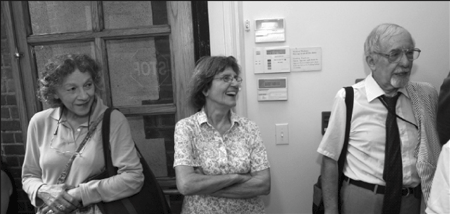By Albert Amateau
Dolores Duncan was 5 years old back in 1932 when she walked into the new Village home of the Little Red School House on Bleecker St. off Sixth Ave. on the first day it opened. At 8 a.m. last Monday she was on hand again to celebrate Little Red’s 75th anniversary in the building.
“Yes, I turned 80 this year,” said Dolores Duncan Wharton, looking 20 years younger than her age. “I was here the first day — Elisabeth Irwin was at the door. I was with the 5s — we went by ages then instead of grades. I came with my brother. He was three years older and he had gone to public school before he came here,” she recalled.
Dr. Ernest Lieber, who works at Bronx Lebanon Hospital, was 7 years old when he first came to Little Red School House in 1936.
“I started in public school a year or two before,” he recalled. “My mother waited with me in a cement schoolyard and she said, ‘This is not for Ernest.’ And the next year she brought me here. Tuition for the whole year then was $100 — certainly no more than $125 — and there were many scholarship students.”
There are still many scholarship students — about 23 percent, according to Phil Kassen, director of Little Red/Elisabeth Irwin High School — but the annual tuition is now $26,000.
“It’s a matter of concern,” Kassen said. “We’re becoming concentrated at the two ends of the economic scale and getting thin in the middle, our traditional base. We’re trying to come up with ways to deal with it.”
From left, Olga K. Heisler and Naomi Burgum Smith, both 1943 Little Red Schoolhouse graduates; and Ernest Lieber, 78, a 1941 Little Red graduate, at anniversary day.
In 1921, Elisabeth Irwin put her ideas about progressive education — based on the pragmatic philosophy of John Dewey — into practice in the Village at P.S. 41 on Greenwich Ave. at W. 11th St. But traditionalist critics had the public school program defunded in 1932. Nevertheless, Irwin was able to acquire the Bethlehem Chapel at 196 Bleecker St. where today Little Red students from pre-K to fourth grade still learn how to explore and take part in the life of the city, the country and the world.
Elisabeth Irwin died in 1942, but her spirit lives on, and about twice a year she reappears for special occasions, personified by Suzanne Cohen, assistant director of Little Red’s middle school. In an ankle-length pink dress, white, brimless hat and pearls, Cohen stood at the door on anniversary day Monday when she and the students played their parts to the hilt.
“Hello, Miss Irwin.”
“Hello, children, welcome to your new school.”
Cohen confided to a reporter, “I raided the high school’s theater costume collection for this,” referring to her period dress. “And I can give you a real Elisabeth Irwin quote from 1932. It says everything about Little Red School House.” Cohen took a breath and said, “‘The school will not always be the way it is now. But it will always be where ideas can thrive, where heresy will be looked upon as possible truth and where prejudice will dwindle for lack of room to grow.’”
Michael Patrick, an attorney and chairperson of the board of trustees of LREI, was also on hand. Raised in Stuyvesant Town, Patrick came to Little Red in 1958 when he was 5 and graduated from Elisabeth Irwin High School on Charlton St. in 1971.
“This is a school that cares a lot, not only about math and science, but about art and music,” Patrick said. “It’s not just about the Village. It was and is a place where children can learn to take their place as members of society and participate as citizens.”
Cliff Hurwich, a statistics professor at New York University’s Stern School of Business who was raised in the Village, recalled coming to Little Red as a 13-year-old after another progressive school, Downtown Community School on E. 11th St., closed.
“I spent a year at Little Red and graduated from Elisabeth Irwin,” he said. “I went to Amherst where we got the same kind of individual attention that I had at Elisabeth Irwin — it was great.” Hurwich earned his doctorate in statistics at Princeton and remains a devoted supporter of LREI.
Olga Karlovna Heisler remembered walking to Little Red as a child in 1943 when her family lived in the Village. She and Naomi Burgum Smith, who came to Little Red in 1935, reminisced along with Dolores Duncan about their school days. They remembered the class trips that introduced them to the city’s workplaces and cultural centers — the Fulton Fish Market, Metropolitan Museum of Art and American Museum of Natural History. Duncan’s first class trip was to the George Washington Bridge, which was nearing completion in 1932.
LREI was just a small elementary school 75 years ago — about 150 students to begin with, compared to about 580 in all grades pre-K to 12 today. The foreign language department includes French and Spanish, as well as Mandarin.
“When we were adding a third language we were thinking of Chinese or Arabic,” Kassen said. “We chose Chinese because we had a better chance to hire a good teacher of Mandarin. We hope to add a fourth language, Arabic, in the future.”



































